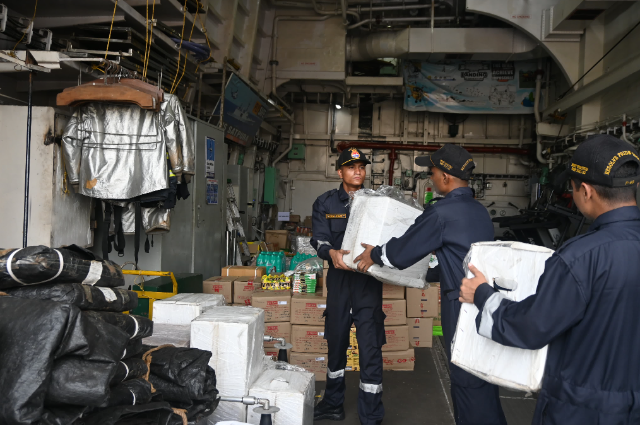
In response to the catastrophic flooding in Myanmar caused by Typhoon Yagi, the Indian Navy has swiftly mobilized to provide critical humanitarian assistance and disaster relief (HADR). The Indian Navy’s efforts emphasize India’s commitment to supporting its neighbouring countries during times of crisis.
Typhoon Yagi: Asia’s Most Powerful Storm of 2024
Typhoon Yagi, which originated from the South China Sea has been labelled as the most powerful storm in Asia this year. It’s devastating effects have been felt across multiple countries in Southeast Asia with Myanmar being severely impacted by flash floods. The storm first struck the Philippines and it claimed over a dozen lives before continuing westward and causing destruction in southern China, Vietnam, Thailand, Myanmar, and Laos.
The storm marked by intense rainfall and violent winds has left behind a trail of destruction, flooding entire regions and leaving communities struggling to cope with the aftermath. In northern Vietnam and Thailand, many areas remain submerged under water even a week after the storm’s initial landfall that is highlighting the severe and ongoing nature of the crisis.
Indian Navy’s Swift Response
In a remarkable show of preparedness and speed, the Indian Navy’s Eastern Naval Command in coordination with several other naval units has rapidly organized the deployment of relief materials to Myanmar. This overnight operation involved the loading of essential supplies onto naval ships stationed at Visakhapatnam. These relief supplies which include HADR equipment, drinking water, food rations, and medical supplies, are on route to Yangon, Myanmar.
Despite the short notice, the Navy’s quick action reflects its ability to mobilize resources efficiently in response to natural disasters. According to an official statement, the Navy's readiness to assist in the region showcases its commitment to humanitarian efforts.
Operation Sadbhav: India’s Regional Humanitarian Support
India’s Ministry of External Affairs also highlighted the broader regional response to Typhoon Yagi. External Affairs Minister S. Jaishankar announced that under Operation Sadbhav, India is sending aid not only to Myanmar but also to Vietnam and Laos. This demonstrates India's solidarity with its Southeast Asian neighbours.
Jaishankar, in a public message had revealed that 10 tons of essential aid including dry rations, clothing, and medicines had already been dispatched to Myanmar onboard the Indian Navy’s INS Satpura. Additionally, the Indian Air Force (IAF) is transporting 35 tons of aid to Vietnam. These supplies include water purification equipment, blankets, kitchen utensils, and solar lanterns. For Laos, India is providing 10 tons of relief materials such as generators, hygiene supplies, mosquito nets, and sleeping bags.
The Regional Impact of Typhoon Yagi
The widespread damage caused by Typhoon Yagi has left a profound impact on Southeast Asia. As the storm moved from the Philippines to southern China and further into Myanmar, Vietnam, Laos, and Thailand, it unleashed heavy rainfall and strong winds that led to loss of life and extensive property damage.
In the affected regions, communities are now grappling with the challenges of rebuilding. The severe flooding in northern Vietnam and northern Thailand has caused large-scale disruptions to daily life, as people struggle to recover from the storm’s devastation.
India’s prompt response to Typhoon Yagi is a testament to its growing role as a regional leader in humanitarian aid and disaster relief. Through the coordinated efforts of the Indian Navy and broader government initiatives like Operation Sadbhav, India is providing much-needed support to its neighbouring countries in their time of need. The rapid deployment of aid to Myanmar and other affected nations reaffirms India’s commitment to regional cooperation and its capability to assist during crises.
The Indian Navy’s involvement in this relief effort highlights its operational efficiency and readiness to assist in humanitarian missions by ensuring that vital supplies reach those in need swiftly and effectively.
The Annual Joint HADR Exercise: Fostering Disaster Preparedness and International Cooperation
The Annual Joint HADR Exercise also known as CHAKRAVAT is a significant event that showcases India's commitment to disaster response and international collaboration. This exercise which began in 2015 following a directive from the Honorable Prime Minister during the Combined Commanders' Conference has evolved into a multi-agency endeavour involving all three branches of the Indian Armed Forces, Paramilitary Forces, several disaster response organizations, NGOs, academic institutions, and international organizations.
The Importance of CHAKRAVAT
CHAKRAVAT serves as a platform for various stakeholders to come together and synergize their efforts in addressing humanitarian crises and natural disasters. The exercise provides an opportunity to develop collective and coordinated effective response mechanisms which are crucial in the face of the increasing vulnerability of the Indian Ocean Region (IOR) to natural disasters due to climate change.
Rotating Hosts and Expanding Participation
The Annual Joint HADR Exercise has been conducted by the Indian Army, Indian Navy (IN), and Indian Air Force (IAF) in rotation since 2016. The last edition of the exercise was hosted by the IAF in Agra and the 2023 edition is being hosted by the Indian Navy in Goa from 09 to 11 Oct 23. This year's edition will witness participation from eight countries of the Indian Ocean Region further strengthening international cooperation in disaster response.
SAGAR: India's Vision for Inclusive Ocean Development
Developing collective and coordinated effective response mechanisms to address humanitarian crises and natural disasters aligns with India's inclusive vision for the oceans known as SAGAR (Security And Growth for All in the Region). HADR operations form a key component in the Indian Navy's Caring Role, demonstrating India's commitment to ensuring the safety and well-being of its citizens and the region as a whole.
The Annual Joint HADR Exercise, CHAKRAVAT is a testament to India's dedication to disaster preparedness and international cooperation. By bringing together various stakeholders and fostering collaboration among nations, this exercise contributes to the development of effective response mechanisms and strengthens the resilience of the Indian Ocean Region in the face of humanitarian crises and natural disasters.
. . .
References:
